|
 |
 |
 |
 |
 |
|
 |
|
|
|
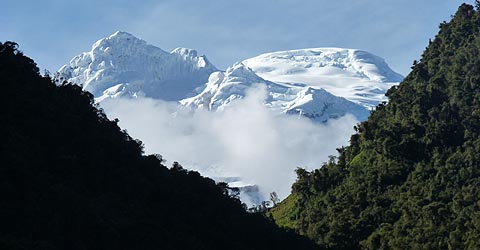 |
|
|
New East/West Slope Combo Itinerary
We have designed a new itinerary which spans both East and West slopes for an unparalleled bird bonanza. We have also arranged lodging to minimize drive time and hotel hopping. This tour visits productive and exemplary reserves of 3 endemic bird areas, Chocó, Interandean and East Slope Andes with a chance at 80 endemics!
Day 0
Arrive Quito on international flight. Overnight Hotel Sebastian.
Day 1
Leave Quito early morning for Yanacocha (Inca Ditch, 3400m). This high elevation temperate forest holds many specialties; including the endemic and critically endangered Black-breasted Puffleg, which comes to the feeders mostly April - Sep. We spend the morning here looking for this very rare species as well as Curve-billed Tinamou, Plain-breasted Hawk, Andean Guan, Scaly-naped Amazon, and more Hummingbirds including Great Sapphirewing, Sword-billed Hummingbird, Buff-winged Starfrontlet, Sapphire-vented and Golden-breasted Puffleg, Mountain Velvetbreast, Tyrian Metaltail and Purple-backed Thornbill.
At the forest borders there is also a chance of Rainbow-bearded Thornbill. Other birds to look for are Bar-bellied and Powerful Woodpecker, Rufous and White-browed Spinetail, Undulated and Rufous Antpitta, White-banded and White-throated Tyrannulet, Crowned Chat-Tyrant, the beautiful Barred Fruiteater, Rufous Wren, Blue-backed Conebill, the local Black-chested Mountain-Tanager as well as Hooded and Buff-breasted Mountain-Tanager, the gorgeous Golden-crowned Tanager, and the rare Paramo Seedeater.
|
|
|
 |
Cloud-forest Pygmy-Owl
Photo by Roger Ahlman
Black-chinned Mountain-Tanager
Photo by Janos Olah Jr.
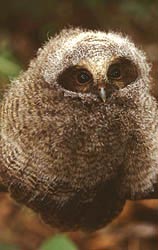
Mottled Owl (Juvenile)
Photo by Charlie Vogt |
After enjoying our box lunches we head to the new road to Mindo stopping to look for White-tailed Shrike-Tyrant just past the Equator monument and later to bird at an orchid reserve for Turquoise Jay and Tanager flocks. We then bird the lower Tandayapa Valley arriving for dinner at Bellavista Lodge in a beautiful Cloud Forest Reserve at 2000m with 700 hectares of protected land and 9 km of trails.
Day 2
In the morning we bird around Bellavista looking for 3 spectacular Chocó endemics; Toucan Barbet, Plate-billed Mountain-Toucan and Tanager Finch (the only spot in Ecuador for this unique and elusive species), also locating Tanager flocks and return for lunch at the lodge. In the afternoon we visit Tony and Barbara's place for an incredible visual feast of hummingbirds at the feeders including the great Empress Brilliant, Green-tailed Trainbearer and maybe the rare Little Woodstar (up to 24 species in one day have been seen, a world record!) as well as intercepting mixed flocks.
After dusk we shall try for Rufescent Screech-Owl (sometimes split and called Colombian Screech-Owl), Band-winged and Swallow-tailed Nightjar. Rufous-bellied Nighthawk often flies around the Lodge area.
Day 3
Early morning birding around the lodge and after breakfast we head up to Tandayapa pass looking for Ocellated Tapaculo, Beautiful Jay. After lunch we head off to Mindo looking for mixed Tanager flocks which also contain many flycatchers, woodcreepers and ovenbirds. In particular we'll be on the lookout for Black-chinned Mountain-Tanager, Flame-faced Tanager, Grass-green and Glistening-green Tanager, also Green-and-Black Fruiteater and Crimson-rumped Toucanet. Overnight Septimo Paraiso.
Day 4
We start at the "hottest" new site, which has been written up in ABA's Birding as well as Neotropical Birding, Paz de las Aves where Rodrigo Paz has habituated Great, Yellow-breasted and Moustached Antpittas as well as Ochre-breasted Antpitta and Dark-backed Wood-Quail. In addition we visit a very active Cock-of-the-Rock lek with up to a dozen extravagant males displaying raucously. Fruitfeeders bring in Sickle-winged Guan, Toucan Barbet, Crimson-rumped Toucanet, Black-chinned and Blue-winged Mountain-Tanager as well as the ghostly Olivaceous Piha.
Afternoon we visit another new site, Mashpi reserve for Moss-backed Tanager, Glistening-green Tanager, Indigo Flowerpiercer, White-tailed Hillstar, Orange-breasted Fruiteater and the newly discovered for Ecuador, Choco Vireo. Overnight same lodge.
 Back to top Back to top 
Day 5
An early start to bird the waterfall trail road above Mindo for Red-headed Barbet, Bay Wren, Crimson-rumped Toucanet and Yellow-faced Grassquit as well as a chance of Orange-crowned Euphonia. Late morning coffee break watching the Hummingbird feeders at Los Colibries Restaurant. Afternoon visit to Milpe road to begin ticking the birds described for day 6. We bird our way leisurely back to the lodge for lunch looking for Golden-headed Quetzal, Scarlet-backed and Golden-olive Woodpecker as well as Golden-rumped, Orange-bellied and Golden-crowned Euphonia. PM birding around the lodge or out the waterfall road. Overnight same lodge.
Day 6
We head off down-slope on the Milpe road for delightful sights such as the exquisite Club-winged Manakins displaying at a lek, Broad-billed Motmot, Chocó Toucan, Pale-mandibled Araçari, Yellow-collared Chlorophonia as well as Rufous-throated. A visit to the fuitfeeders at the Mirador restaurant in Los Bancos can sometimes yield up to a dozen species of tanagers as well as Crimson-rumped Toucanets and Black-cheeked Woodpeckers.
Day 7
An early start driving to Silanche Reserve beyond Pedro Vicente Maldonado. We bird the reserve for many Lowland Chocó endemics such as Black-striped Woodcreeper, Yellow-crowned Tyrannulet, Slaty-capped Shrike-Vireo, Chocó Warbler, Scarlet-breasted Dacnis, Emerald, Gray-and-gold, Scarlet-and-White, as well as Blue-whiskered Tanagers. Box breakfast on the tower often yields a lot of bird activity with Cinnamon Woodpecker, Scarlet-rumped Cacique, Tawny-crested, Rufous-winged and Scarlet-browed Tanagers as well as Dusky Pigeon, Rose-faced Parrot and Tiny Hawk.
After lunch we bird around the lodge and head back to Quito. Overnight Hotel Sebastian.
Day 8 - Quito to Papallacta to Guango Lodge
Early start from Hotel San Sebastian in Quito, heading up to Papallacta pass at 4200m. Here we will search for paramo specialties like the Rufous-bellied Seedsnipe, with luck Andean Snipe, Caranculated Caracara, Ecuadorian Hillstar, Blue-mantled Thornbill, Stout-billed Cinclodes, Andean Tit-Spinetail, Many-striped Canastero, White-chinned Thistletail, Tawny Antpitta, the rare Red-rumped Bush-Tyrant, Paramo Ground-Tyrant, Grass Wren and with a good weather a chance on Andean Condor!
After enjoying our box-lunches, we will descend the eastern slope and visit a stand of Polylepis forest for Giant Conebill, Black-backed Bush-Tanager and Paramo Tapaculo. Behind the forest there is a beautiful lake in which Silvery Grebe, Andean Coot, Andean Ruddy-Duck and Andean Teal can be found.
Later we will reach Guango Lodge at around 2700m which maintains a beautiful garden with many flowers and feeders for Hummingbirds. Up to 12 species can be seen in one day and this must be the best place in the world to see Sword-billed Hummingbird. Other special hummers here include the very rare Mountain Avocetbill, Tourmaline Sunangel, Glowing and Golden-breasted Puffleg. At dusk we will look for Rufous-bellied Nighthawk.
Night at Guango Lodge.
Day 9 - Guango Lodge to Cabanas San Isidro
Morning birding around Guango Lodge which offers several habitats including cloudforest, chusquea bamboo and a fast flowing river. Here we can see Torrent Duck, Masked Trogon, Turquoise Jay, with luck the rare Gray-breasted Mountain-Toucan, Bar-bellied Woodpecker, Chestnut-naped Antpitta (very difficult to see!), Rufous-breasted Flycatcher, Slaty-backed Chat-Tyrant, Barred Becard, Plain-tailed Wren, White-capped Dipper, Blue-backed and Capped Conebill, Buff-breasted Mountain-Tanager, the beautiful Plushcap as well as Northern Mountain-Cacique.
After lunch we will depart for Cabanas San Isidro. As we drop in altitude new birds show up, and we will specially search for mixed species flocks. If it is a sunny day several species of raptors could be seen like Black-and-chestnut Eagle, Short-tailed and White-rumped Hawk. Later in the afternoon we arrive at Cabanas San Isidro; a privately owned lodge with almost 1200 hectares of protected land and a birdlist of over 300 species.
|
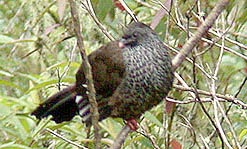
Andean Guan
Photo by Roger Ahlman
|
Some specialties that we will look for include Sickle-winged Guan, White-throated Quail-Dove, White-capped Parrot, Barred Parakeet, Powerful and Yellow-vented Woodpecker, Highland Motmot, Crested and Golden-headed Quetzal, Black-billed Mountain-Toucan, Rusty-winged and Spotted Barbtail, Streaked Tuftedcheek, Striped Treehunter, Slate-crowned and White-bellied Antpitta, Barred Antthrush, the beautiful Rufous-crowned Tody-Flycatcher, Bronze-olive Pygmy-Tyrant, Handsome and Pale-edged Flycatcher, the rare Dusky Piha, a lek of Andean Cock-of-the-Rock, Inca Jay, Black-billed Peppershrike, Chestnut-breasted Chlorophonia, several gorgeous Tanagers as well as Subtropical and Yellow-billed Cacique.
At night we shall look for Rufous-banded Owl and a high elevation Black-banded Owl that might be new species!
Over night at Cabanas San Isidro.
Day 10 - Cabanas San Isidro and Guacamayos Ridge
|
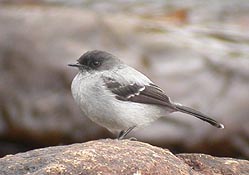
Torrent Tyrannulet
Photo by Charlie Vogt
|
Morning birding around San Isidro along the road and their varied forest trails looking for birds we missed yesterday. Later we will check the feeders for Fawn-breasted Brilliant, Chestnut-breasted Coronet, Long-tailed Sylph, Bronzy Inca, Tawny-bellied Hermit and, if we are lucky, maybe the very rare Gorgeted Woodstar.
After lunch we will go towards the Guacamayos ridge east of San Isidro, where we will bird the whole afternoon until dusk. This ridge drops down towards the Amazon so here we have a chance for a lot of new species not found at the higher elevation of San Isidro. We shall look for Scaly-naped Amazon, White-tipped Sicklebill, Booted Racket-tail, Wire-crested Thorntail, White-tailed Hillstar, Greenish Puffleg, the near endemic Coppery-chested Jacamar, Black-streaked Puffbird, Rufous-rumped Antwren, Variegated Bristle-Tyrant, the rare Olivaceous Piha, Golden-winged Manakin, Gray-mantled Wren, Chestnut-bellied Thrush, Vermilion Tanager, chance on the very rare White-rimmed Brush-Finch.
Just after dusk we might find Swallow-tailed and Band-winged Nightjar, and White-throated Screech-Owl.
Night at Cabanas San Isidro.
Day 11 - Cabanas San Isidro to Wildsumaco
|
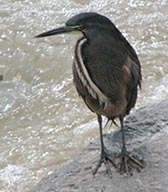
Fasciated Tiger-Heron
Photo by Bob Pease
|
In the morning we continue to explore San Isidro and the Guacamayos ridge.
After enjoying our box-lunches we shall explore the beginning of the Loreto Road. Many common birds abound here in the secondary forest and adjacent pastures. Yellow-browed Sparrow, Dark-breasted Spinetail, Olive-chested Flycatcher and Tropical Kingbird are just a few of the inhabitants we will encounter. As we drive along the road the scenery changes and we will have some spectacular views of the east Andean foothills as well as the Amazonian lowlands. We will make several stops at lush patches of tall rainforest looking for Blue-naped Chlorophonia, Golden-eyed Flowerpiercer and with luck Spot-winged Parrotlet and Military Macaw. Along the steep roadcuts several Cliff Flycatchers can be seen sallying for insects together with Blue-and-white Swallow. We will make a prolonged stop at one of the taller cliffs scoping for the rare Orange-breasted Falcon. Other birds here include the shy Wing-banded Wren and the near endemic Coppery-chested Jacamar. Overnight Wildsumaco Lodge.
Day 12 - Wild Sumaco.
Here, in the foothills of the eastern Andes rising from the Amazon, we find one of the highest diversities of bird-species of any area in the world. We will concentrate on mixed species flocks and flowering trees that attract many species of hummingbirds as well as other nectar craving visitors. Some of the birds we might see today include Black Hawk-Eagle, Gray-rumped Swift and hummers like Violet-headed Hummingbird, Ecuadorian Piedtail and Golden-tailed Sapphire. Other possibilities are Collared Trogon, Spot-breasted Woodpecker, Lafresnaye's Piculet, Striolated Puffbird, Chestnut-tipped Toucanet, Equatorial Graytail, Black-billed Treehunter, Lined Antshrike, Blackish Antbird, Short-tailed Antthrush and several species of flycatchers, for example Black-and-white Tody-Tyrant, Cliff Flycatcher and Yellow-cheeked Becard. Two colorful cotingas are possible namely Scarlet-breasted and Fiery-throated Fruiteater and we have a chance on Amazonian Umbrella-bird. Other interesting species include Blue-rumped Manakin, Musician Wren, Golden-eyed Flower-piercer and several flashy tanagers including the spectacular Paradise as well as Yellow-throated and Orange-eared Tanager.
At night we shall try for Rufescent Screech-Owl and the localized Band-bellied Owl. Foothill Screech-Owl and Blackish Nightjar are also possible. Dinner and overnight at the new Wild Sumaco Lodge run by Jonas's foundation which protects over 500 acres of Foothill rainforest harboring over 325 species with many foothill specialties.
Day 13 - Wild Sumaco.
In the morning we will continue looking for more birds and of special interest in this area is Rufous-naped Greenlet, the recently described Foothill Elaenia, Yellow-breasted Antwren that often accompanies mixed species flocks high in the canopy together with Gray-mantled Wren, Streaked Xenops, Ecuadorian Tyrranulet, the rare White-fronted Tyrranulet and Lemon-browed Flycatcher. Sometimes a Black Hawk-Eagle soars high above the forest or a loud flock of Maroon-tailed Parakeets flashes through the mid canopy. Overnight at Wild Sumaco Lodge.
Day 14 - Wild Sumaco and back to Quito.
In the morning we continue to clean up on foothill specialties and later in the afternoon we reluctantly leave this birding El Dorado and head back towards Quito looking for more birds along the way.
Dinner and overnight at Hotel Sebastian in Quito
We wind up this week's flurry of birds and drive off to Quito arriving at the hotel in the early evening.
 Back to top Back to top 
Tour Information
Price per person: Click here for prices
Included: All lodging, meals, expert bilingual birdguide, transportation, hotel transfer and entrance fees.
Not included: Last night dinner; drinks; tips.
See our Payment and Cancellation Policy page for important information.
|
 |
|
|
|